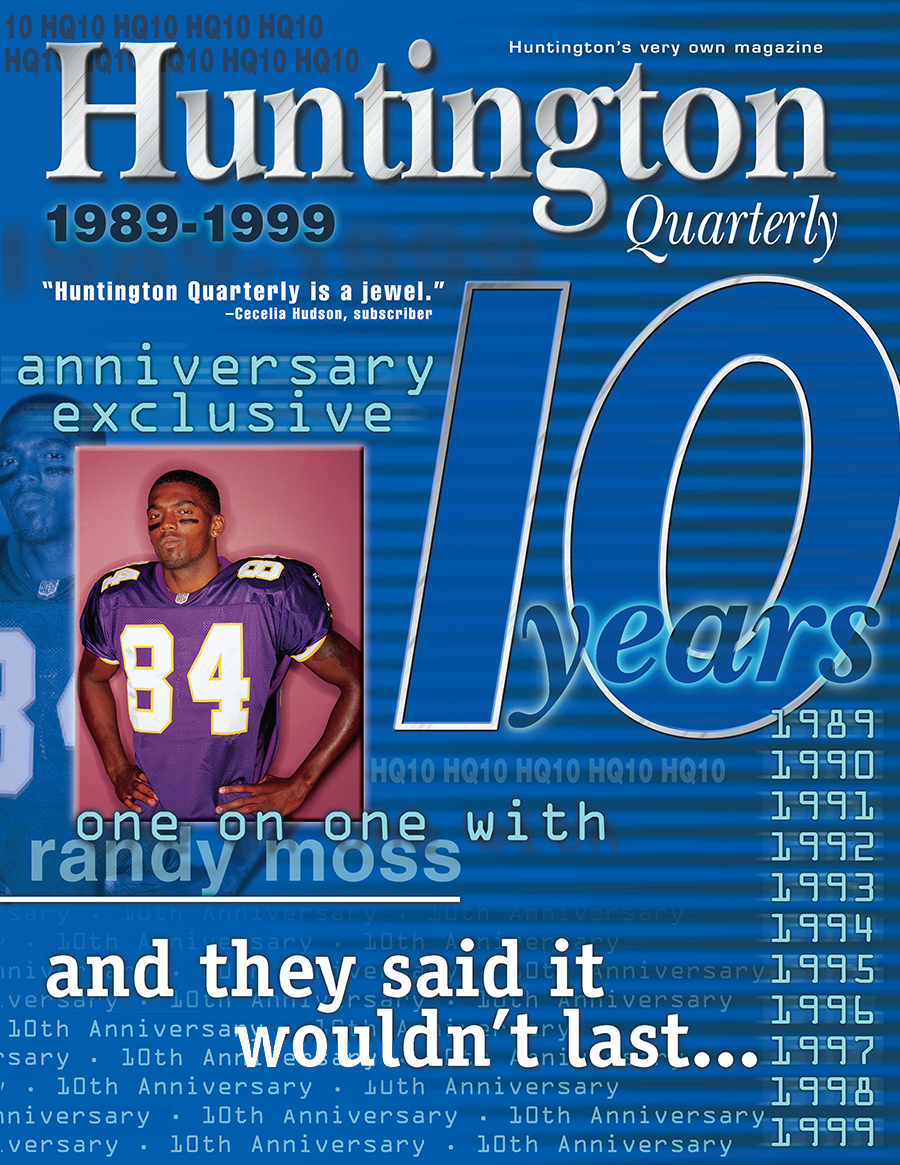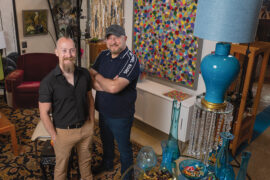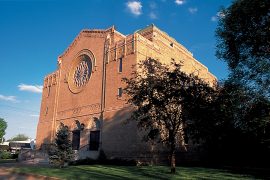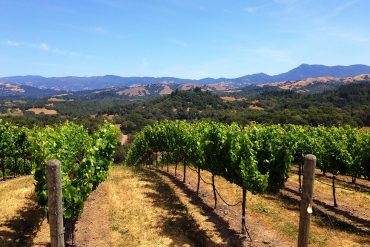HQ celebrates its milestone 10 year anniversary with a look back at an exciting decade of publishing.
By The Editors
HQ 37 | WINTER 2000
And they said it wouldn’t last. In 1989 when the magazine premiered, they said it wouldn’t last a year. Then, after our one year anniversary, they said it wouldn’t last a second. And finally, after our five year anniversary, they insisted it wouldn’t survive to see a 10th Anniversary. Well, here we are, a little battle-worn from the pressures of the publishing game, but here nonetheless. Despite the skeptics who proclaimed that Huntington would never support a full color magazine, (after all, Huntington just wasn’t big enough) we’re alive and well. But, more importantly, we’re proud to publish Huntington’s very own magazine dedicated to showcasing the positive aspects of this unique community.
Over the last 10 years, we have told the story of Huntington and been a part of an exciting decade of change. We have recalled our community’s rich history, profiled the region’s most dynamic leaders, visited luxurious homes and cheered the successes at Marshall University. All in all, it has been a good run.
And so for our 10 Year Anniversary, we the editors decided to take a stroll down memory lane and recall some HQ history as well as some Huntington history. And for good measure, we have thrown in some telling tales about the so-called glamorous world of magazine publishing.
The premier issue of Huntington’s namesake magazine was released in the fall of 1989 with great fanfare. The magazine featured articles on civic leader A. Michael Perry, John F. Kennedy’s historic visit to Huntington and the “Fall and Rise” of Marshall University football ‹ little did we know then how far the football program would continue to climb. The cover, an oil painting of an autumn scene at Ritter Park, was done by prominent local artist Adele Thornton Lewis. The issue also looked inside the Morgan home on Camelot Drive ‹ the first of many homes to be spotlighted by our “Homes” section which soon became our most popular feature.
The magazine dedicated itself to highlighting positive profiles of area residents, regional history, success stories of local businesses and always a story on “The University.” Feedback began arriving almost immediately in support of the new publication:
“It’s a pleasure to see a magazine dedicated to the happenings of Huntington …”
“I am tremendously impressed. The magazine smacks of quality throughout …”
“A lovely magazine! We especially like the positive statement about Huntington.”
Over the next several years the magazine continued to grow, picking up more subscribers and advertisers. It celebrated its one year anniversary and began adding more color and improving the overall design of the product. As years passed, we continued to do our job of writing and proofreading, layout and photography, unaware that we were watching the decade of the 90s unfold in the pages of our publication.
In the last 10 years, we have marveled at the tremendous growth in the health care field and have reported on the transformation of the region’s two largest hospitals, the Marshall University School of Medicine and countless other health-related jobs that have flourished in the local economy.
At Marshall University, the heart and soul of the city, we have been a witness to phenomenal growth. HQ was there on that glorious fall night in 1991 when the new 30,000 seat football stadium opened. A volcanic eruption halfway around the world cast a brilliant red tone across the night sky over the stadium and we captured it on film. We were at the stadium a year later for the dramatic and emotional 1992 NCAA Division I-AA National Championship victory. In the years that followed, we covered the program’s jump to the Mid-American Conference and Division I-A competition, a near victory at WVU, Randy Moss madness, MU’s first modern day bowl appearance, two Heisman contenders and, as this article is being written, a Top 15 national ranking. Put simply unbelievable.
Elsewhere on campus, the rate of progress during President J. Wade Gilley’s tenure in the 1990s has been equally impressive: an $18 million Fine and Performing Arts Center; merger with the West Virginia Graduate College in South Charleston; $31 million high-tech library; $32 million medical center at Cabell Huntington Hospital; $80 million in technology infrastructure; revamping of the undergraduate program; and other academic advances too numerous to mention. In Huntington, we have seen a resurgence of activity in the downtown with new restaurants coming and going, old buildings being renovated for new tenants and talk, yet again, of the development of the SuperBlock. In addition, three new ultra-modern consolidated high schools opened, a new four-lane bridge was completed spanning the Ohio River, the Huntington Museum of Art continued to expand and professional hockey hit the ice at the Civic Arena.
On the down side, we felt the loss of longtime corporate neighbor Ashland Inc. and watched helplessly as Toyota decided to build its newest American engine plant in Putnam County after a Cabell County couple refused to sell their land for the project.
In addition to covering much of the defining moments of the 1990s, we have had our fair share of adventures as well. From interesting photo shoots to an interview with an academy award winning actor and everything in between, we’ve seen a lot.
There was the time Editor Jack Houvouras and Contributing Photographer Ed Wright chartered a single-engine plane (piloted by an 18 year old) to capture an aerial photograph of a mansion on the Ohio River. As they went gliding down the banks of the river, the pilot asked which house was being photographed and Houvouras pointed downward. The pilot abruptly banked hard right and dove on the home like a WWII ace as “Steady Eddie Wright” fired off some film. As the pilot began to pull up, Houvouras noticed that the East End Bridge was coming hard into view, but luckily the young hot shot missed the structure by a few feet. The pilot and Wright chuckled. Houvouras nearly lost his breakfast.
Another memorable photo shoot took place on the floor of Marshall University’s Henderson Center. HQ Photo Editor David Fattaleh was there to cover the last game of MU basketball great John Taft, whose jersey was being retired that evening. Fattaleh positioned himself underneath one of the baskets to shoot up at the action, but just seconds into the game, a player blocked a shot which sent the ball hurling directly into the unsuspecting photographer’s face. You could hear the “smack” reverberate throughout the Henderson Center and the crowd reacted with a powerful “Ooooooh!” Fattaleh’s eye glasses cut deep into the bridge of his nose resulting in a bit of blood. MU staffers on the scene all agreed he needed stitches, but Fattaleh refused. He still bears the scar from that horrible night. Ask him and he will proudly show you.
Of course one of our favorite stories involved the woman, the house and the plant. While photographing one of Huntington’s most exclusive homes, the owner kept following Fattaleh from room to room with a small, decorative plant ‹ the kind you might receive as a “Get Well Soon” gift from the florist. In any event, the gracious homeowner tried to carefully place the little plant in every room we photographed, not to mention an outside shot of the pool. “She really must have liked that plant,” Fattaleh reasoned. “But, it would have looked odd with the same plant in every picture. So, we ended up having to digitally remove the plant from several of the rooms.”
We will never forget our trips to more exotic locales such as New York City where we braved life and limb to photograph Broadway star Mark McVey in the midst of racing traffic in Times Square. We returned to New York years later to spend an afternoon with Huntington icon Soupy Sales.
We traveled to Florida to share a round of golf with living legend Bill Campbell on the exclusive Donald Ross-designed Seminole Golf Club in Juno Beach. We returned later to interview Shoney’s founder Alex Schoenbaum at his home in Long Boat Key.
Washington, D.C. was the site of two trips as well. The first to interview Sen. Robert C. Byrd, Sen. Jay Rockefeller and Rep. Nick Rahall for a feature on “The Future of West Virginia.” On our second trip we spent a day with “The Godfather of Political Consulting,” Huntington native Matt Reese.
Of all the dramas that have unfolded at the magazine, the most memorable would have to be our cover story on actor Paul Newman. In 1993, 25 years after Newman’s historic, yet secretive, visit to Huntington where he spent four days studying for his infamous role as “Cool Hand Luke,” HQ decided to contact the academy award winning actor regarding a story on his memories of that trip.
Houvouras wrote the actor but didn’t expect to receive a reply since Newman rarely grants interviews. But three weeks later, just after noon, the phone rang in the Huntington Quarterly office. Associate Editor Anne Conaty was out to lunch, so Houvouras manned the phone, answering, “Huntington Quarterly.”
“Is Jack Houvouras there?” a cool voice inquired.
“Speaking,” Houvouras replied.
“Newman here,” the man stated.
“Yeah, right,” Houvouras quipped, thinking it was a prank from a friend.
“Who the hell is this?”
Indeed it was Paul Newman, who then humbly apologized for his delay in responding before agreeing to an interview. A unique black and white photograph of Newman graced the cover of the Autumn 1993 issue. The image was selected out of respect for the actor’s efforts to direct attention away from his notorious baby blue eyes. As Newman himself said in the article, “I’d like to think there’s a mind functioning somewhere in Paul Newman, and a soul, and a political conscience and a talent that extends beyond the blueness of my eyes.”
In addition to Newman, we have had the privilege of profiling a diverse group of people that have had an impact on Huntington.
We recall names such as Huntington businessman Marshall Reynolds, Mayor Jean Dean (whose cover photo appeared on “The Rosie O’Donnell Show” in 1996), Gov. Gaston Caperton, Gov. Cecil Underwood, MU President J. Wade Gilley, philanthropist Joan Edwards and, one of our closest friends, nationally-prominent attorney John Drinko. And that doesn’t even include our cast of characters from the controversial yet widely read “50 People To Watch” cover story.
The magazine has also given us and our readers the chance to learn about the history of the community including stories on the infamous Jesse James bank robbery, the 1937 flood, the establishment of Ritter Park, city founder Collis P. Huntington and the MU plane crash, just to name a few. But of all the articles that have focused on history, the most enlightening piece was our profile of Carter G. Woodson, the Huntington native internationally-known as the “Father of Black History” and the founder of Black History Month.
“After some research, I was shocked and overwhelmed to learn that Huntington had once been home to such a profound scholar, historian and leader,” Houvouras recalled. “Carter G. Woodson is one of the most impressive people to ever come out of Huntington.”
This year, the Huntington Quarterly accepted a new challenge when it entered into a unique partnership with its longtime friend, Marshall University. Marshall magazine, which is distributed to 25,000 Marshall alumni, is our latest publishing venture. The full color, quarterly magazine profiles the success stories not only at the university, but in the Advantage Valley region between Huntington and Charleston.
In ten years, the Huntington Quarterly has generated overwhelming support despite the doomsday predictions of numerous skeptics. HQ now appears to be firmly entrenched in the community as it celebrates its 10 Year Anniversary. But the magazine hasn’t succeeded just to prove naysayers wrong. The real success of the magazine can be attributed to the publication’s namesake itself Huntington, a city unique because of its people and their overriding sense of community pride.
More than anything, these past 10 years have been a period of renewed enthusiasm for the city, and the Huntington Quarterly would like to think it has played a small part in that rejuvenation by producing something tangible that residents can show others and say, “This is my hometown.” When they do, maybe the rest of the world will know why anyone who has lived here will always call Huntington home.





